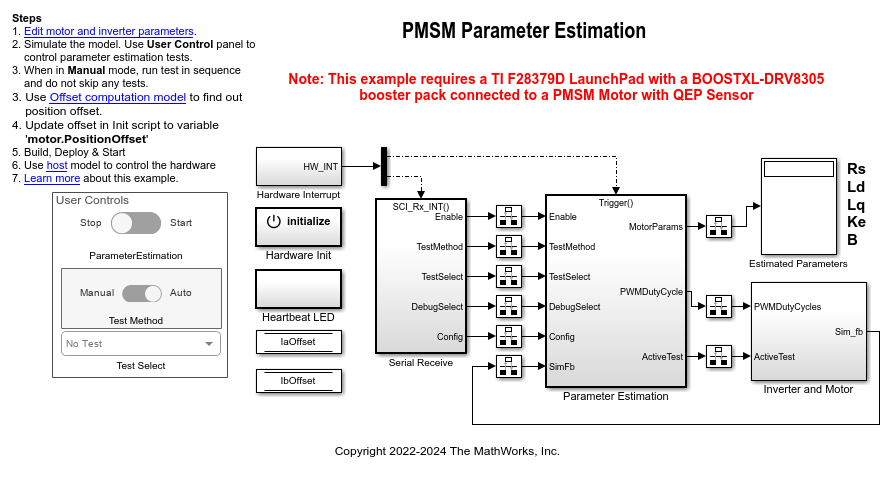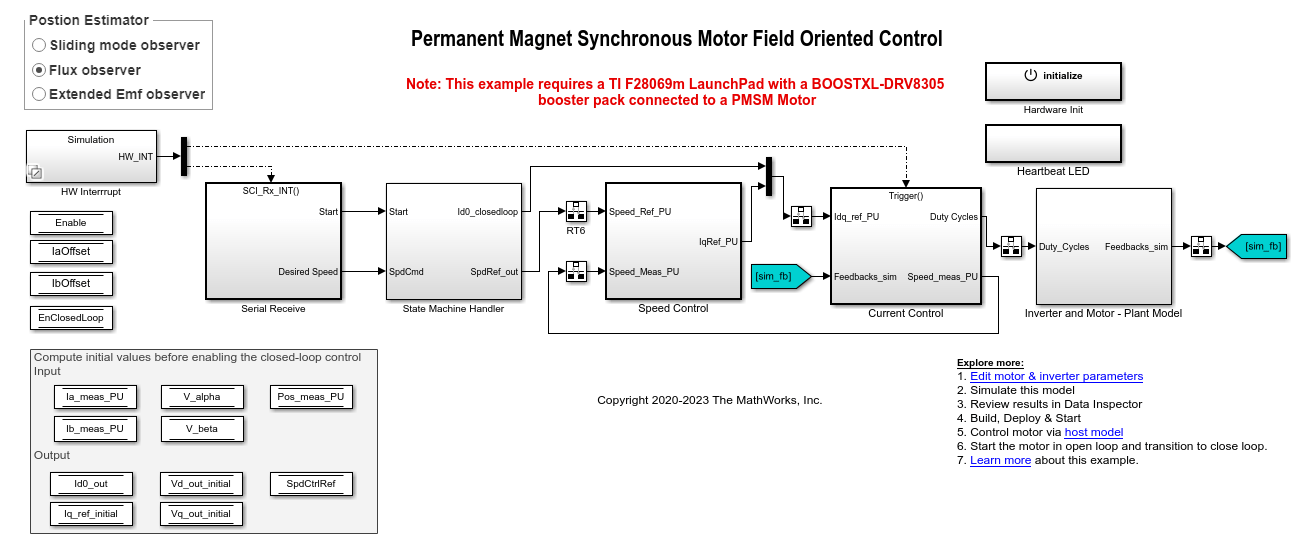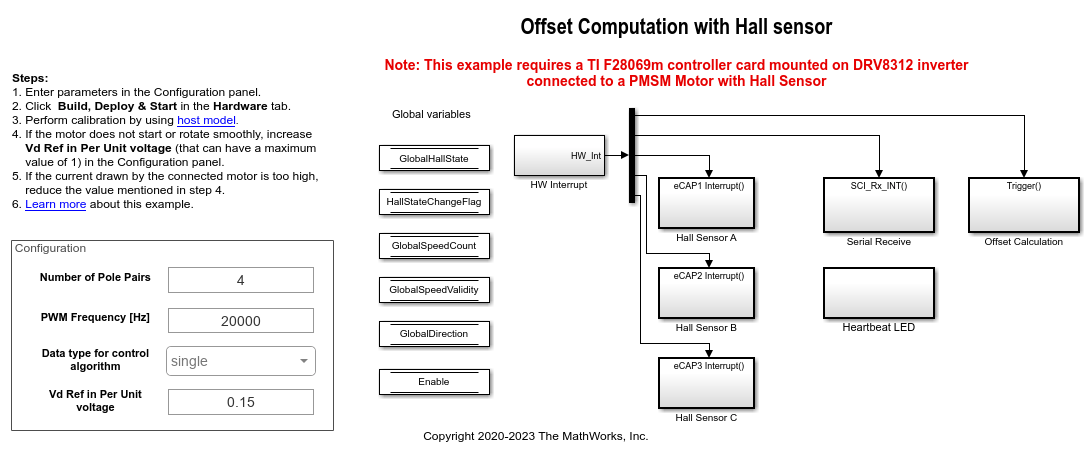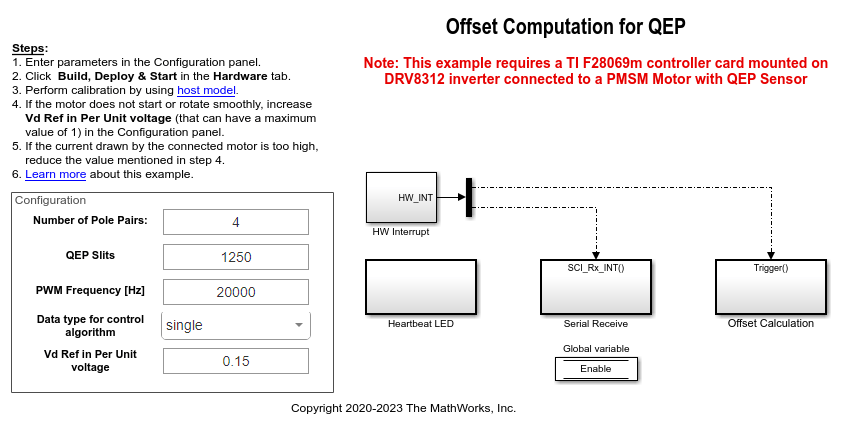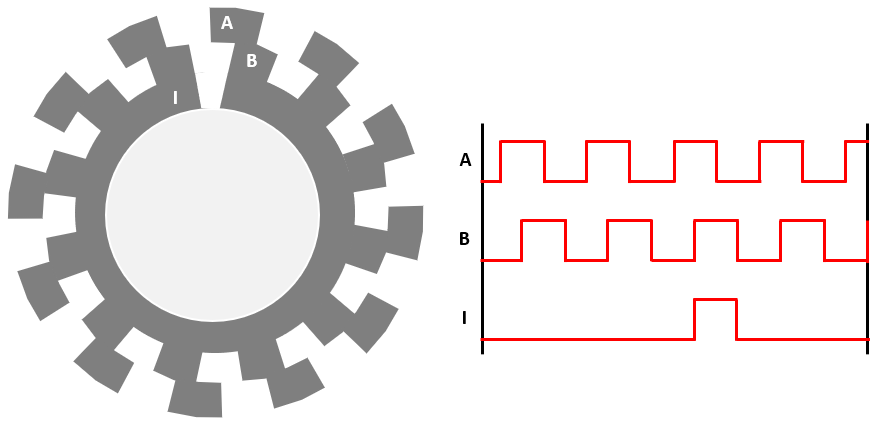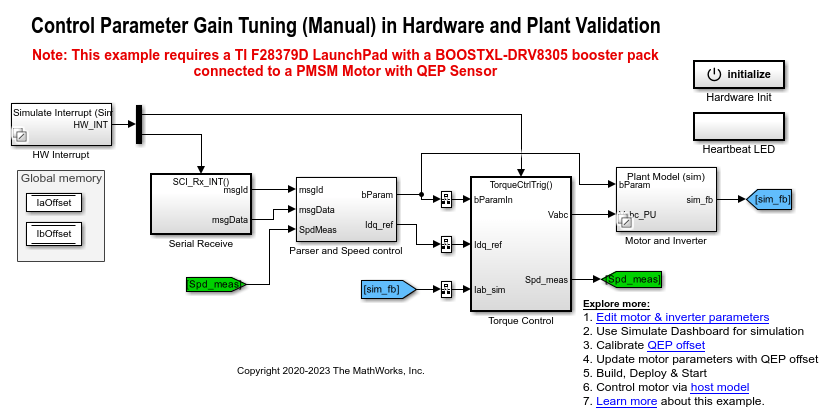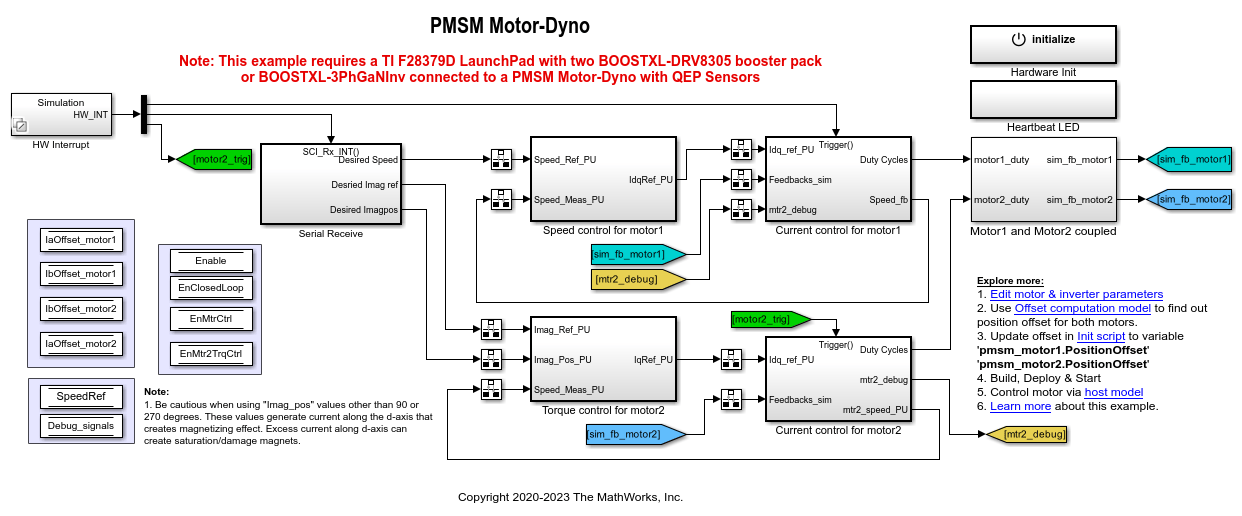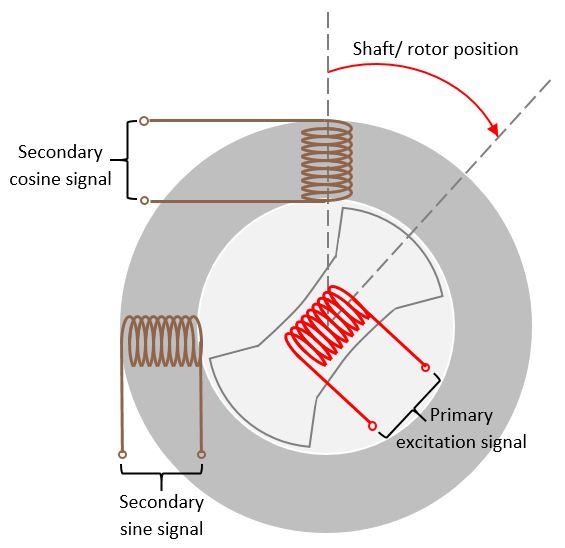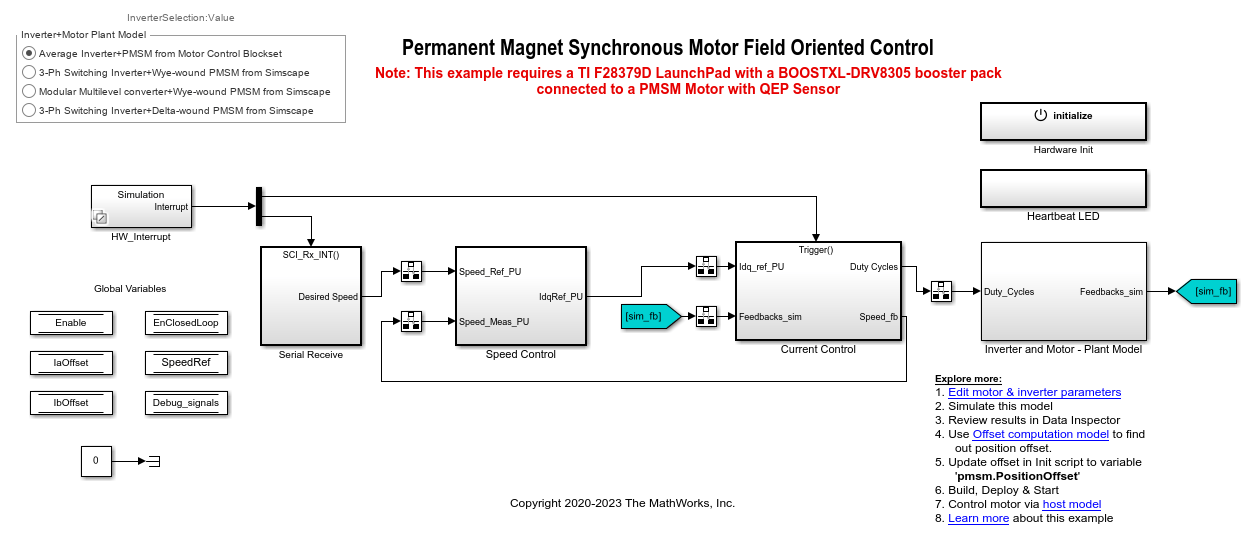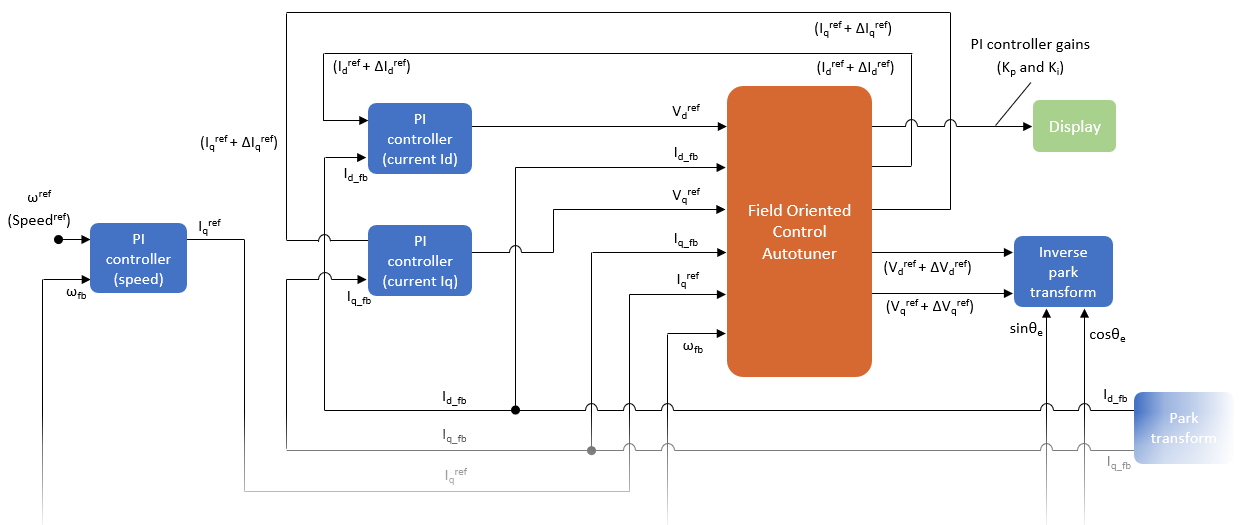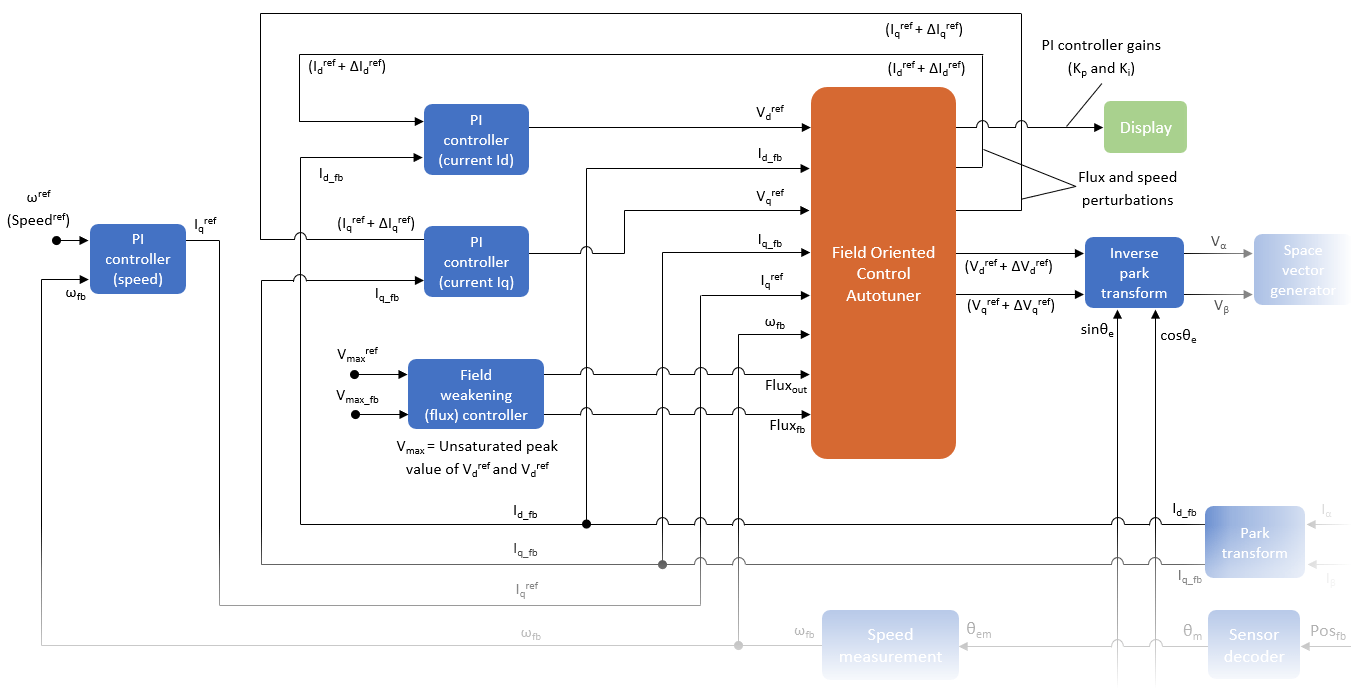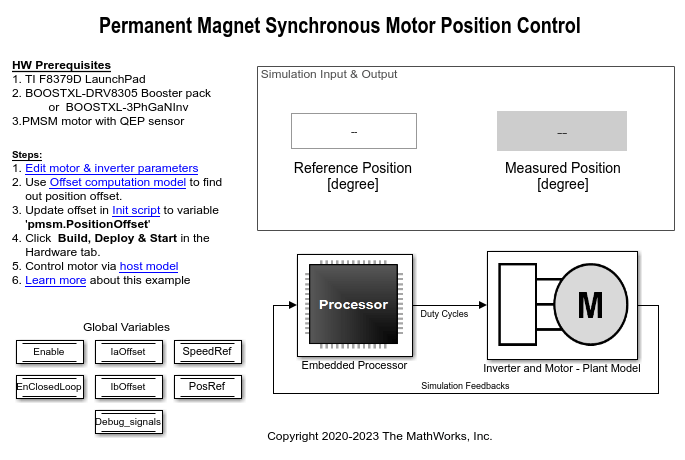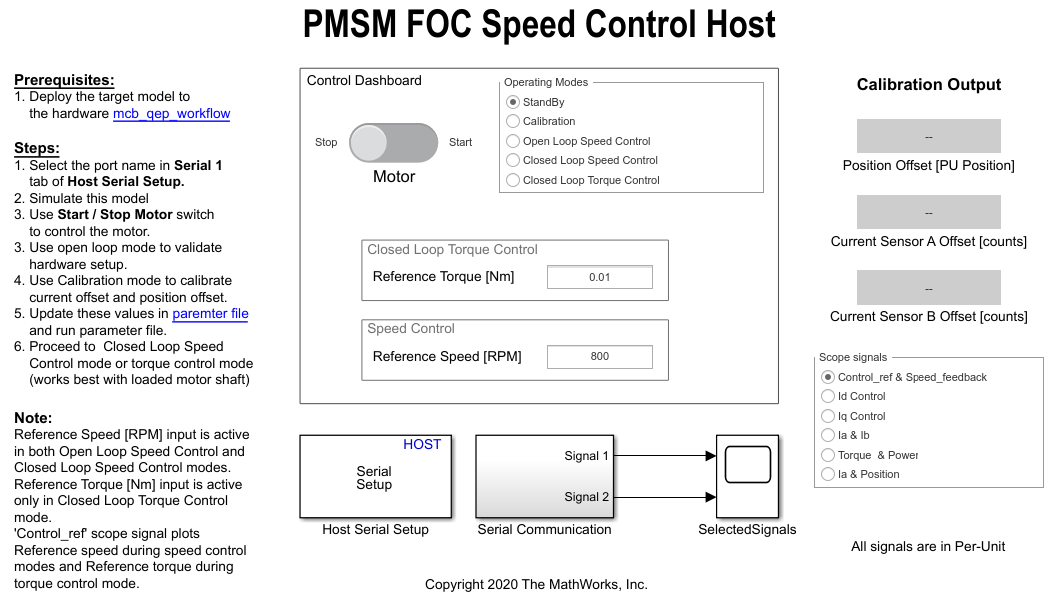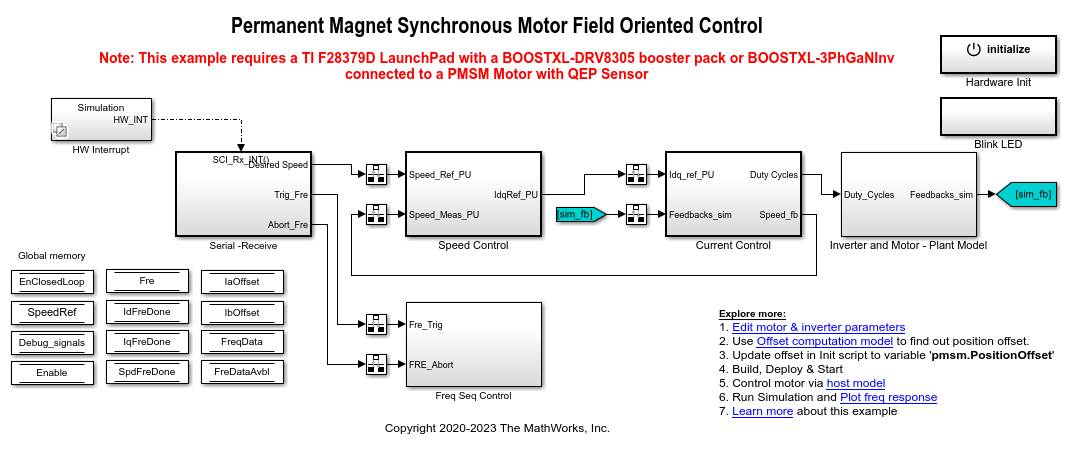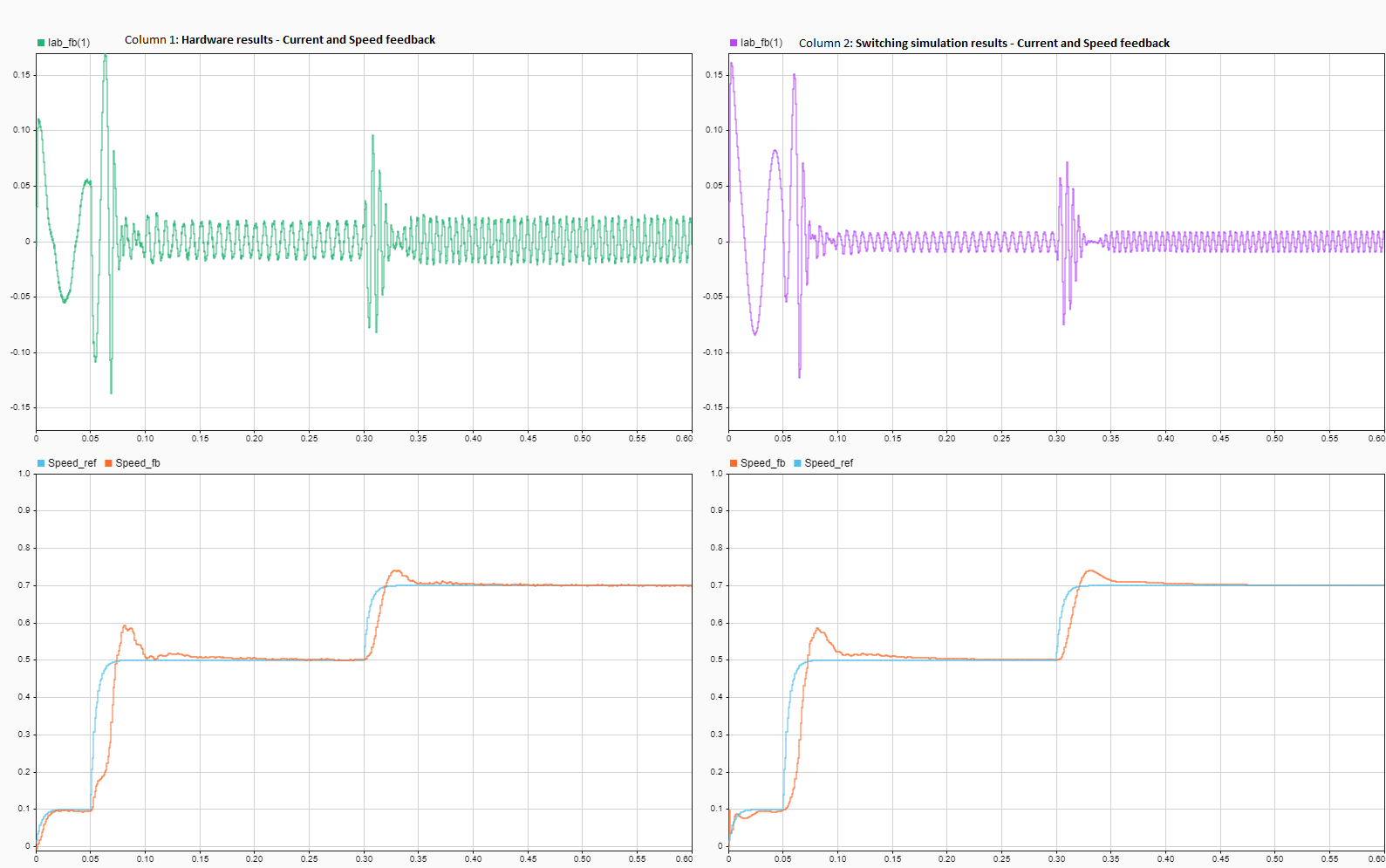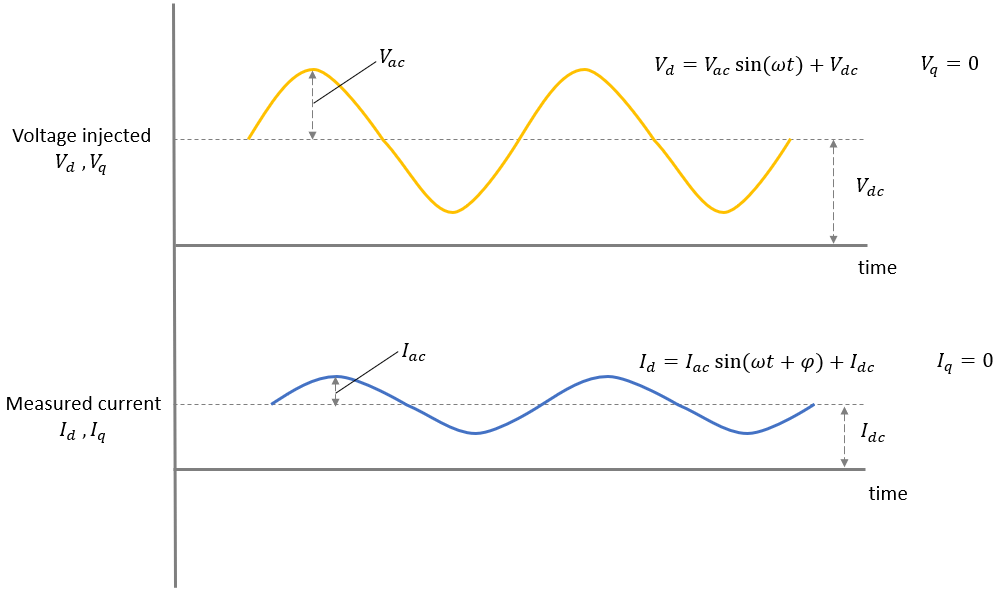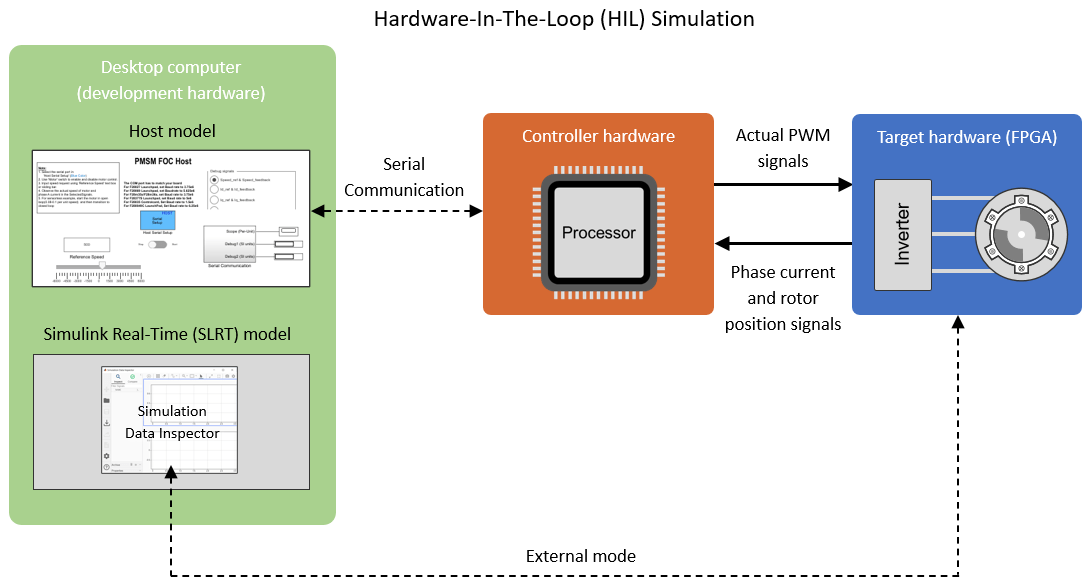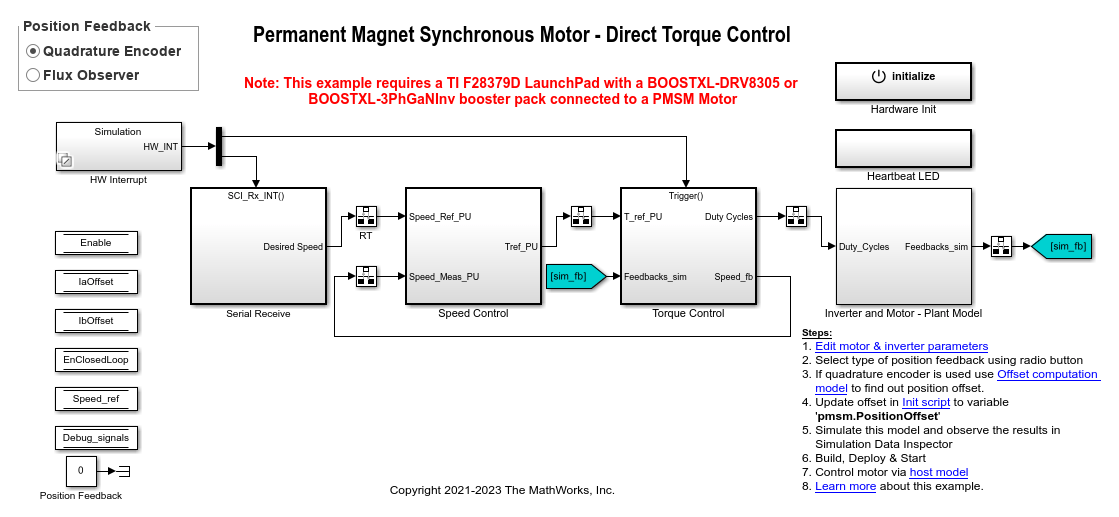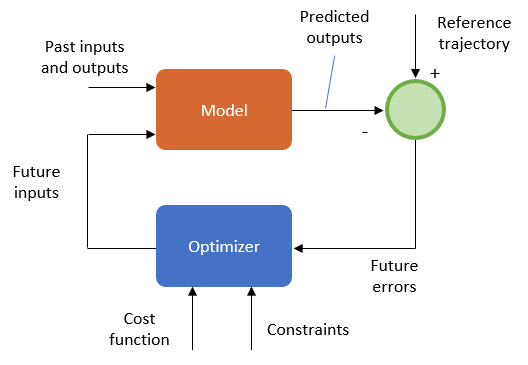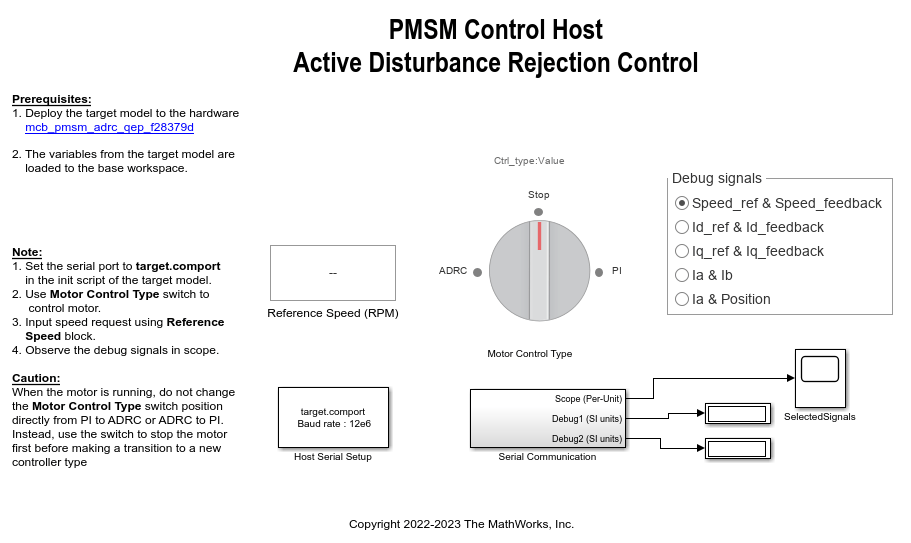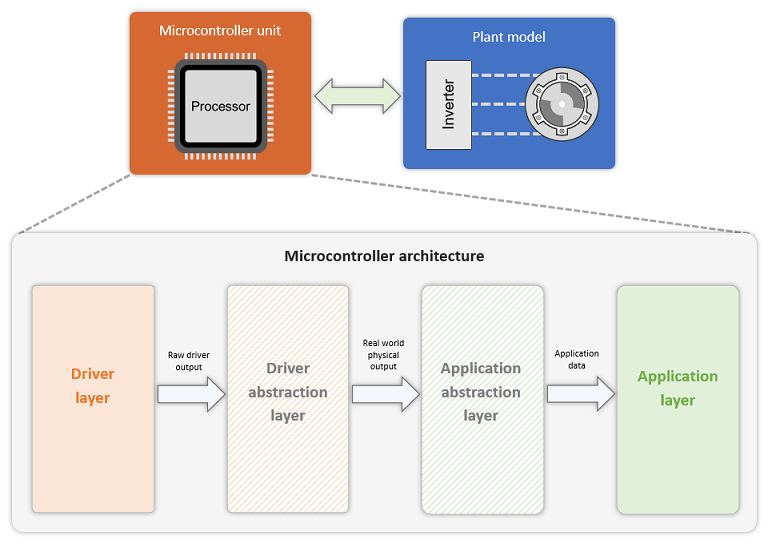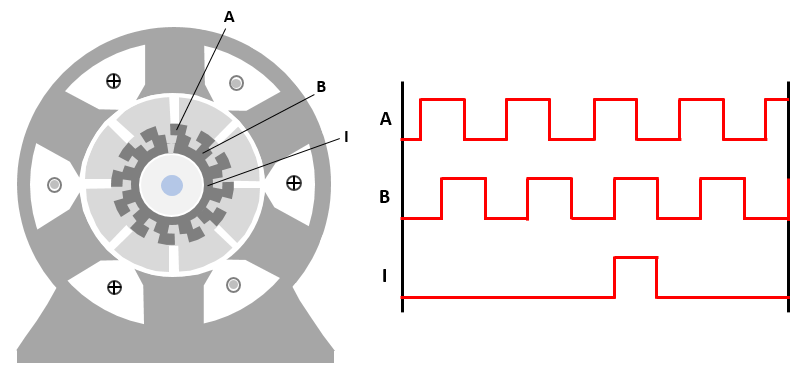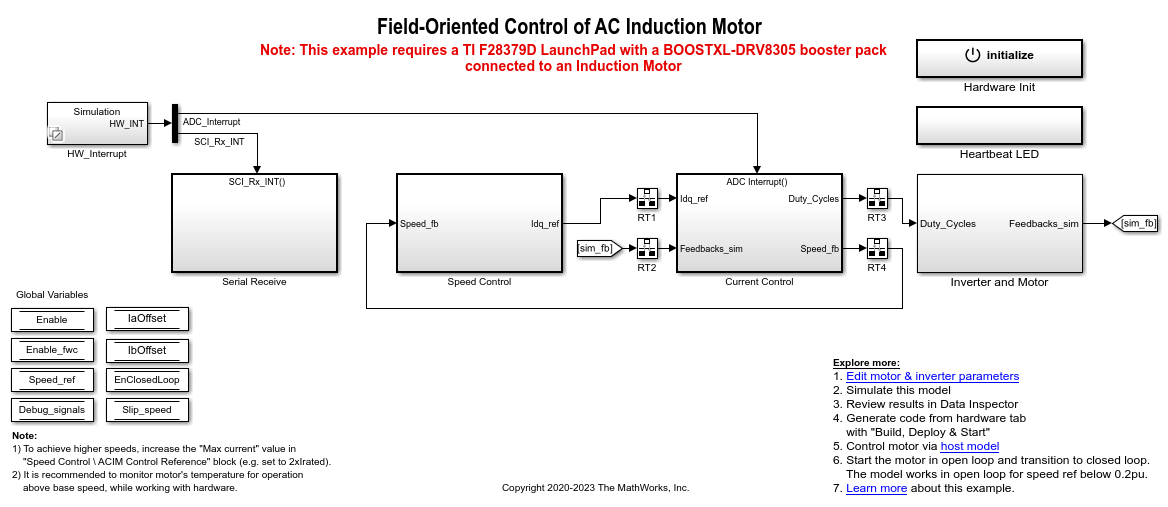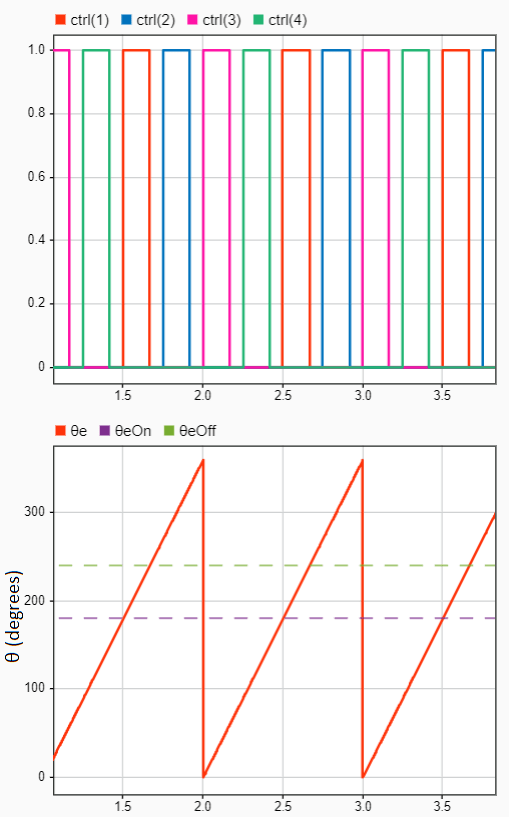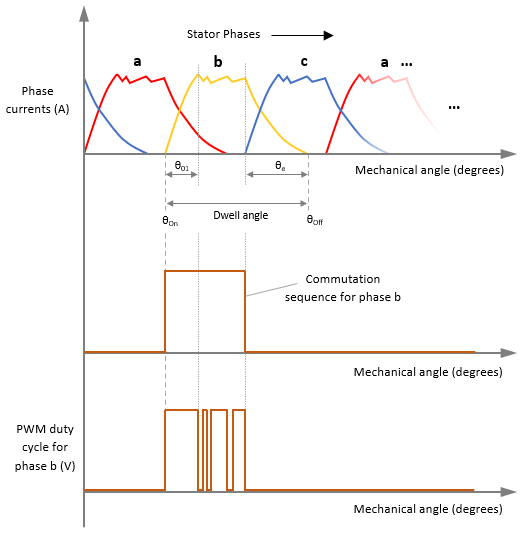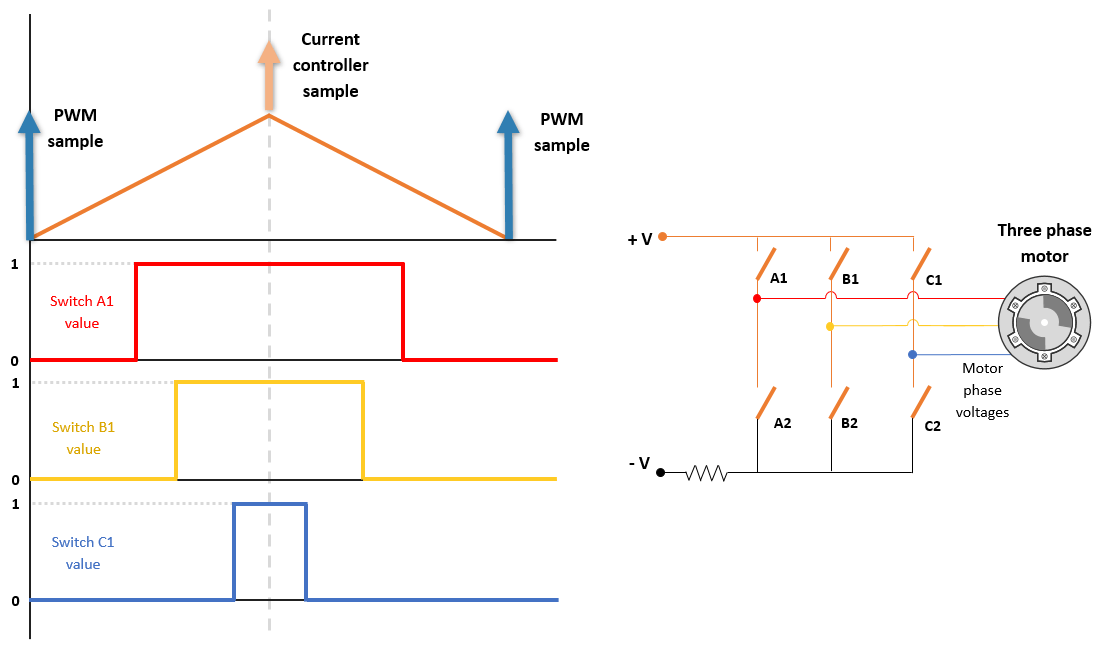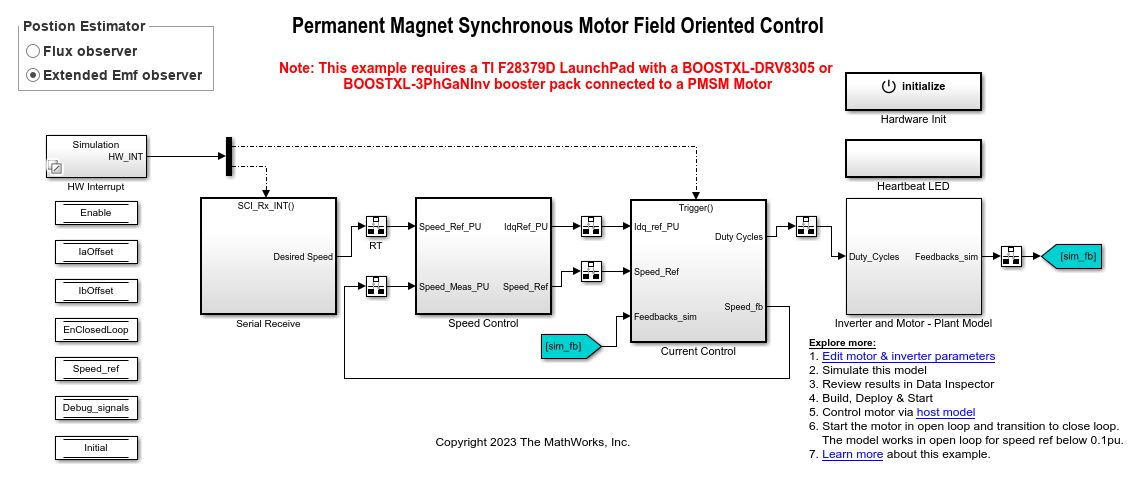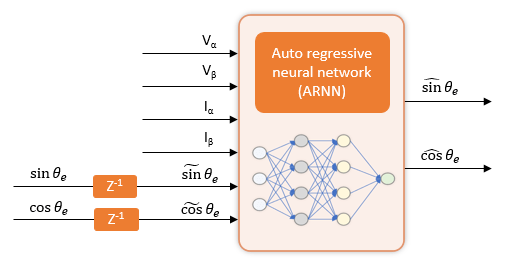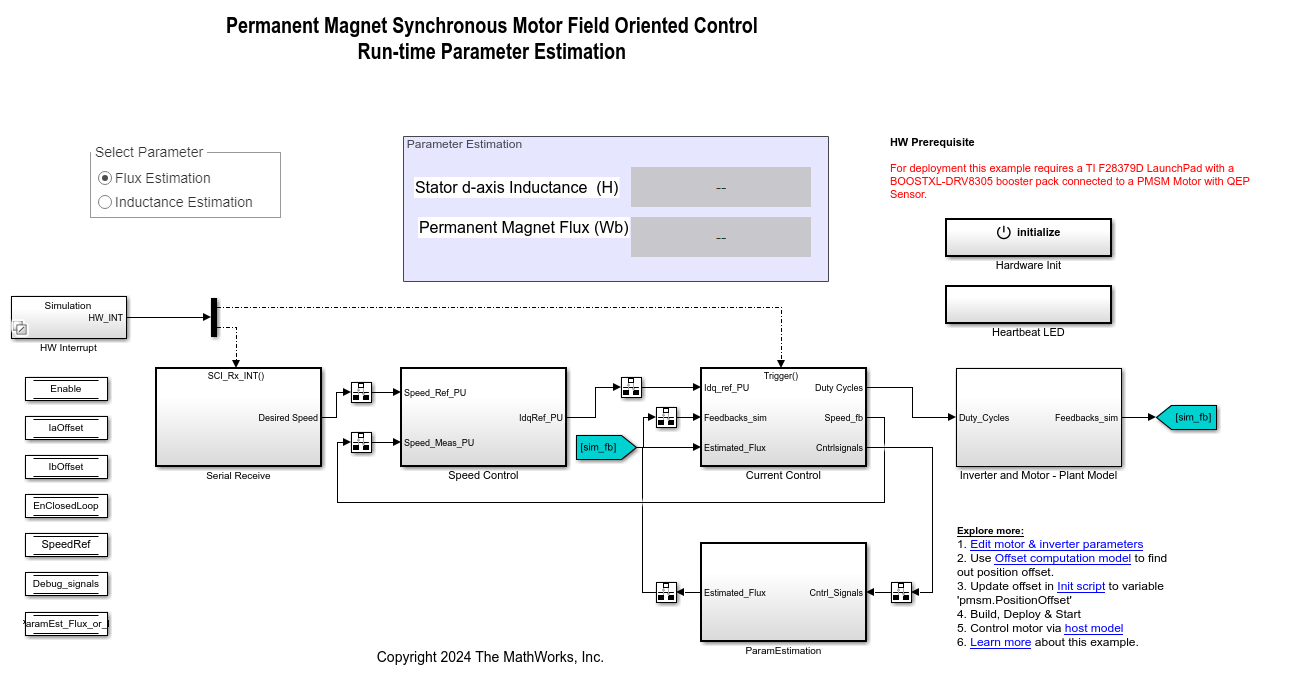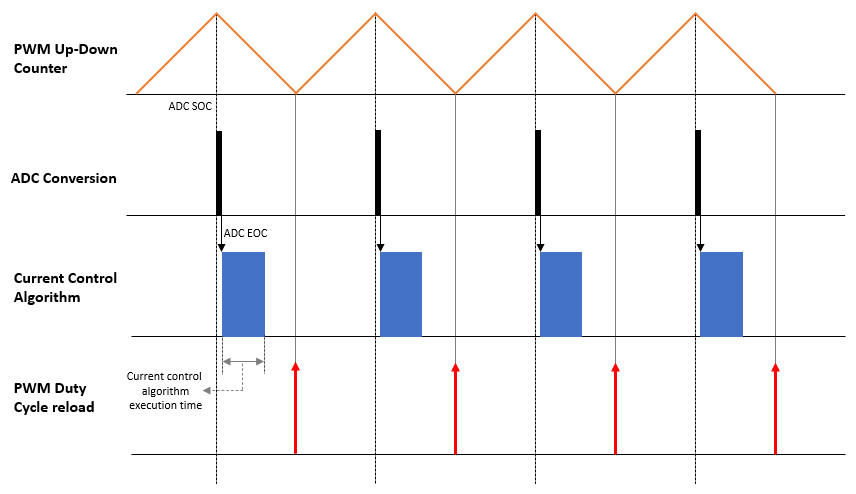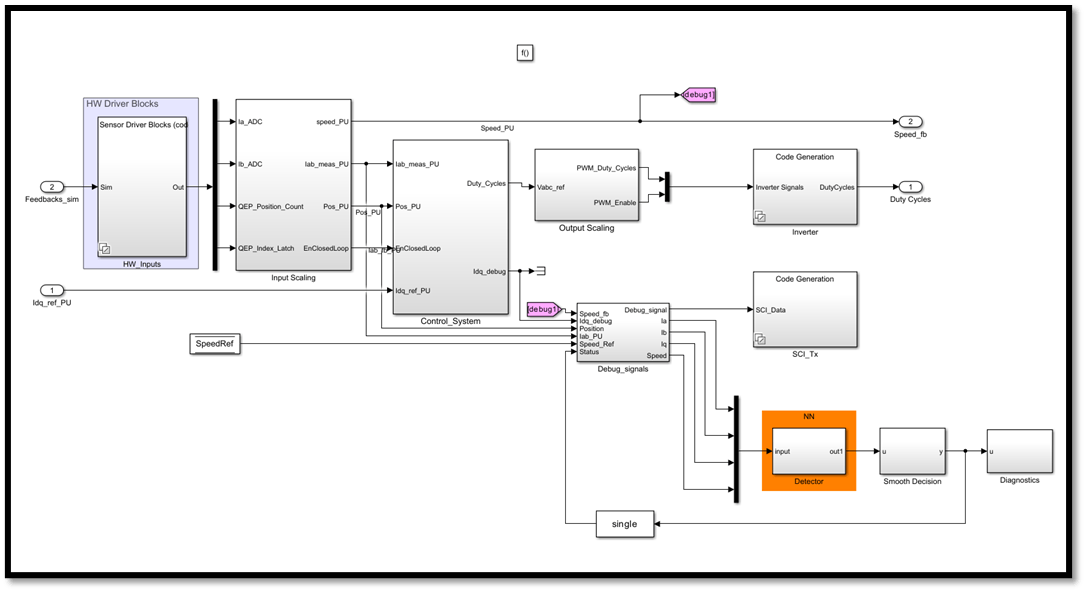Texas Instruments
浏览可以在 Texas Instruments 硬件上进行部署的 Motor Control Blockset™ 示例。
精选示例
以开环控制方式运行三相 AC 电机并校准 ADC 偏移量
此示例使用开环控制(也称为标量控制或伏特/赫兹控制)来运行电机。这种方法会改变定子电压和频率来控制转子转速,而不使用来自电机的任何反馈。您可以使用这种方法来检查硬件连接的完整性。开环控制的恒速应用使用固定频率的电机电源。开环控制的可调速应用需要可变频率电源来控制转子转速。为了确保恒定的定子磁通,请保持电源电压振幅与其频率成比例。
Estimate PMSM Parameters Using Parameter Estimation Blocks
Uses the parameter estimation blocks provided by Motor Control Blockset™ to estimate these parameters of a permanent magnet synchronous motor (PMSM) with a quadrature encoder sensor:
PMSM 的霍尔偏移量校准
此示例计算转子直轴(d 轴)和霍尔传感器检测到的位置之间的偏移量。磁场定向控制 (FOC) 算法需要此位置偏移量来正确运行永磁同步电机 (PMSM)。为了计算偏移量,目标模型在开环条件下运行电机。该模型使用常量 (沿定子
d 轴的电压)和零值 (沿定子
q 轴的电压),通过使用位置或斜坡发生器来运行电机(以低恒定转速)。当位置或斜坡值达到零时,对应的转子位置就是霍尔传感器的偏移值。
使用霍尔传感器的 PMSM 的磁场定向控制
此示例采用磁场定向控制 (FOC) 方法来控制三相永磁同步电机 (PMSM) 的转速。FOC 算法需要转子位置反馈,通过使用霍尔传感器获得该反馈。有关 FOC 的详细信息,请参阅磁场定向控制 (FOC)。
PMSM 的正交编码器偏移量校准
此示例计算转子的 d 轴与正交编码器检测到的编码器索引脉冲位置之间的偏移量。控制算法(在磁场定向控制和参数估计示例中可用)使用此偏移值来计算转子的 d 轴的精确位置。控制器需要此位置以在转子磁通参考系(d-q 参考系)中正确实现磁场定向控制 (FOC),从而正确运行永磁同步电机 (PMSM)。
使用正交编码器的 PMSM 磁场定向控制
此示例采用磁场定向控制 (FOC) 方法来控制三相永磁同步电机 (PMSM) 的转速。FOC 算法需要转子位置反馈,该反馈通过正交编码器获得。有关 FOC 的详细信息,请参阅磁场定向控制 (FOC)。
PMSM 的弱磁控制(使用 MTPA)
此示例采用磁场定向控制 (FOC) 方法来控制三相永磁同步电机 (PMSM) 的转矩和转速。FOC 算法需要转子位置反馈,该反馈通过正交编码器获得。有关 FOC 的详细信息,请参阅磁场定向控制 (FOC)。
Tune Control Parameter Gains in Hardware and Validate Plant
Uses field-oriented control (FOC) to run a three-phase permanent magnet synchronous motor (PMSM) in different modes of operation for plant validation. FOC algorithm implementation needs the real-time feedback of the rotor position. This example uses a quadrature encoder sensor to measure the rotor position. For details about FOC, see 磁场定向控制 (FOC).
使用 SI 单位的 PMSM 磁场定向控制
此示例采用磁场定向控制 (FOC) 方法来控制三相永磁同步电机 (PMSM) 的转速。然而,此示例中的 FOC 算法使用信号的 SI 单位来执行计算,而不使用数量的标幺表示(有关标幺制的详细信息,请参阅标幺制)。以下是信号及其 SI 单位:
Control PMSM Loaded with Dual Motor (Dyno)
Uses field-oriented control (FOC) to control two three-phase permanent magnet synchronous motors (PMSM) coupled in a dyno setup. Motor 1 runs in the closed-loop speed control mode. Motor 2 runs in the torque control mode and loads Motor 1 because they are mechanically coupled. You can use this example to test a motor in different load conditions.
Monitor Resolver Using Serial Communication
Use the resolver sensor to measure the rotor position. The resolver consists of two stator (secondary) windings placed orthogonally around the resolver rotor (primary) winding. After you mount the resolver sensor over a PMSM, the resolver rotor winding rotates with the shaft of the running motor. Meanwhile, the controller provides a fixed-frequency excitation signal (alternating sinusoidal or square pulse) to the primary winding.
Model Switching Dynamics in Inverter Using Simscape Electrical
Uses field-oriented control (FOC) to control the speed of a three-phase permanent magnet synchronous motor (PMSM). It gives you the option to use these Simscape™ Electrical™ blocks as an alternative to the Average Value Inverter block in Motor Control Blockset™:
使用 Field Oriented Control Autotuner 调节 PI 控制器
此示例通过使用 Field Oriented Control Autotuner 模块计算转速和电流控制环中可用的 PI 控制器的增益值。有关此模块的详细信息,请参阅Field Oriented Control Autotuner。有关磁场定向控制的详细信息,请参阅磁场定向控制 (FOC)。
Tune PI Controllers (in Field-Weakening Control Mode) Using FOC Autotuner Block
Uses the Field Oriented Control Autotuner block to compute the gain values of the PI controllers available in the speed, current, and flux control loops of a field-weakening control algorithm. For details about this block, see Field Oriented Control Autotuner.
MATLAB Project for FOC of PMSM with Quadrature Encoder
This MATLAB® project provides a motor control example model that uses field-oriented control (FOC) to run a three-phase permanent magnet synchronous motor (PMSM) in different modes of operation. Implementing the FOC algorithm needs real-time rotor position feedback. This example uses a quadrature encoder sensor to measure the rotor position. For details about FOC, see 磁场定向控制 (FOC).
Frequency Response Estimation of PMSM Using Field-Oriented Control
Performs frequency response estimation (FRE) of a plant model running a three-phase permanent magnet synchronous motor (PMSM). When you simulate or run the model on the target hardware, the model runs tests to estimate the frequency response as seen by each PI controller (also known as raw FRE data) and plots the FRE data to provide a graphical representation of the plant model dynamics.
Integrate MCU Scheduling and Peripherals in Motor Control Application
Identify and resolve issues with respect to peripheral settings and task scheduling early during development.
Partition Motor Control for Multiprocessor MCUs
Partition real-time motor control application on to multiple processors to achieve design modularity and improved control performance.
Estimate Initial Rotor Position Using Pulsating High-Frequency and Dual-Pulse Methods
Estimates the initial position (in electrical radians) of a stationary interior PMSM by using pulsating high-frequency (PHF) injection and dual pulse (DP) techniques.
Field-Oriented Control (FOC) of PMSM Using Hardware-in-the-Loop (HIL) Simulation
Uses hardware-in-the-loop (HIL) simulation to implement the field-oriented control (FOC) algorithm to control the speed of a three-phase permanent magnet synchronous motor (PMSM). The FOC algorithm requires rotor position feedback, which is obtained by a quadrature encoder sensor. For more information on FOC, see 磁场定向控制 (FOC).
使用正交编码器或无传感器磁通观测器的 PMSM 直接转矩控制
此示例采用直接转矩控制 (DTC) 方法来控制三相永磁同步电机 (PMSM) 的转速。直接转矩控制 (DTC) 是一种矢量电机控制方法,它通过直接控制电机的磁通和转矩来实现电机转速控制。该示例算法需要从 PMSM 获取电机电流和位置反馈。它使用 DTC 的空间矢量脉冲宽度调制 (DTC-SVPWM) 变体,该变体使用空间矢量调制 (SVM) 来产生逆变器使用的脉冲宽度调制 (PWM) 占空比。有关此示例中使用的 DTC-SVPWM 算法的更多详细信息,请参阅直接转矩控制 (DTC)。
使用模型预测控制进行 PMSM 的磁场定向控制
此示例采用模型预测控制 (MPC) 技术来控制三相永磁同步电机 (PMSM) 的转速。MPC 是一种控制技术,它通过调整和优化控制系统的输入,以最小化预测系统输出的误差,并在一段时间内实现参考控制目标。该技术涉及求解目标函数,并在每个采样时间点 () 寻找最优输入序列。每个时间步结束后,将当前系统状态视为初始状态,并重复上述过程。
使用 PIL 测试进行代码验证和探查
此示例说明如何在 Texas Instruments® LAUNCHXL-F28379 硬件板上进行 PIL 探查。在处理器在环 (PIL) 仿真中,控制算法在目标硬件中执行,但被控对象模型在主机上运行。被控对象模型对控制器的输入和输出信号进行仿真,并使用串行通信接口与控制器通信。借助此功能,您可以使用 PIL 仿真来确定目标硬件上的执行时间,然后可以将其与主机上仿真模型的执行时间相比较。
Implement PMSM Speed Control Using Active Disturbance Rejection Control
Implement active disturbance rejection control (ADRC) of the speed of a permanent magnet synchronous motor (PMSM) modeled in Simulink® using the Active Disturbance Rejection Control (Simulink Control Design) block. You can use the example to implement field-oriented control (FOC) using either a proportional integral (PI) or ADRC-based controller to run the motor in the speed control mode. Therefore, you can compare the performance of the PI and ADRC controllers.
Swap Motors with Single Model Deployment of Sensor-Based FOC Algorithm
Run a permanent magnet synchronous motor (PMSM) in an industrial drive application setup using position-sensor-based field-oriented control (FOC). Industrial drives enable you to swap motors in real-time without repeated deployment of code. An industrial drive setup needs a fixed inverter and software that has the ability to adapt the control algorithm according to the new motor using only the updated nameplate parameters.
Swap Motors with Single Deployment of Sensorless FOC Algorithm
Run a permanent magnet synchronous motor (PMSM) in an industrial drive application setup using a sensorless field-oriented control (FOC) algorithm. The example uses a sensorless Flux Observer to estimate the motor position. Industrial drives enable you to replace a motor with a new one without repeated deployment of code. An industrial drive setup needs only nameplate parameters to adapt the software to the new motor.
Generate Motor Control Models for Selected Algorithm and Hardware
Use Motor Control Blockset™ to generate a Simulink® model that is configured for a specific hardware and motor control technique.
BLDC 电机的霍尔传感器序列校准
此示例计算开环控制中相对于转子零位置的霍尔传感器序列。此工作流帮助您使用六步换相的方式旋转电机,而无需标记霍尔传感器或推断开关序列。运行此示例并获取霍尔序列,使用此霍尔序列和 Six Step Commutation 模块按照使用传感器反馈对 BLDC 电机进行六步换相示例中的说明以闭环形式运行电机。
Estimate Induction Motor Parameters Using Parameter Estimation Blocks
Uses the parameter estimation blocks provided by Motor Control Blockset™ to estimate these parameters of an AC induction motor (ACIM):
使用转速传感器实现感应电机的磁场定向控制
此示例采用磁场定向控制 (FOC) 方法来控制三相 AC 感应电机 (ACIM) 的转速。FOC 算法需要转子转速反馈,在此示例中通过使用正交编码器获得此反馈。有关 FOC 的详细信息,请参阅磁场定向控制 (FOC)。
感应电机的无传感器磁场定向控制
此示例使用无传感器位置估计来实现磁场定向控制 (FOC) 方法,以控制三相 AC 感应电机 (ACIM) 的转速。有关 FOC 的详细信息,请参阅磁场定向控制 (FOC)。
Commutation of SRM Using Sensor Feedback
Implements a commutation system to control the speed of a three-phase 12/8 switched reluctance motor (SRM).
Dwell Angle Computation for SRM Speed Control
Compute the dwell angle of a 12/8 switched reluctance motor (SRM) online (while the motor runs). The example then uses the computed dwell angle along with a delta controller to control the motor speed.
Sensorless Field-Oriented Control of PMSM Using DC Shunt Current Sensing
Implement sensorless field-oriented control (FOC) using only a single DC bus-based current measurement to run a permanent magnet synchronous motor (PMSM).
使用基于 I-F 控制的启动的 PMSM 无传感器磁场定向控制
此示例使用无传感器位置估计和基于 I-F 控制的启动来实现磁场定向控制 (FOC),以控制三相永磁同步电机 (PMSM) 的转速。
Field-Oriented Control of PMSM Using Position Estimated by Neural Network
Implement field-oriented control (FOC) of a permanent magnet synchronous motor (PMSM) using a rotor position estimated by an autoregressive neural network (ARNN) trained with Deep Learning Toolbox™.
Run-Time Parameter Estimation of PMSM Using Sensor Feedback
Estimate the parameters of a permanent magnet synchronous motor (PMSM) at run-time. The example estimates the following PMSM parameters by running tests while the motor runs using a closed-loop field-oriented control (FOC) algorithm:
Motor Control Architectures Based on Different Current Sampling and PWM Frequencies
Enables you to implement different motor control architectures that use non-identical sampling rates for ADC conversion, PWM, and current controller algorithm to run a permanent magnet synchronous motor (PMSM) using field-oriented control (FOC).
Detect Unbalanced Motor by Using Neural Network
Detect a mechanically unbalanced spinning motor by using a neural network (NN) developed using Deep Learning Toolbox™.
MATLAB Command
You clicked a link that corresponds to this MATLAB command:
Run the command by entering it in the MATLAB Command Window. Web browsers do not support MATLAB commands.
选择网站
选择网站以获取翻译的可用内容,以及查看当地活动和优惠。根据您的位置,我们建议您选择:。
您也可以从以下列表中选择网站:
如何获得最佳网站性能
选择中国网站(中文或英文)以获得最佳网站性能。其他 MathWorks 国家/地区网站并未针对您所在位置的访问进行优化。
美洲
- América Latina (Español)
- Canada (English)
- United States (English)
欧洲
- Belgium (English)
- Denmark (English)
- Deutschland (Deutsch)
- España (Español)
- Finland (English)
- France (Français)
- Ireland (English)
- Italia (Italiano)
- Luxembourg (English)
- Netherlands (English)
- Norway (English)
- Österreich (Deutsch)
- Portugal (English)
- Sweden (English)
- Switzerland
- United Kingdom (English)

